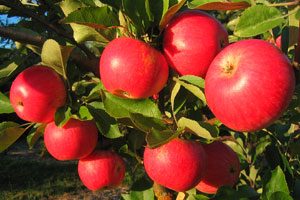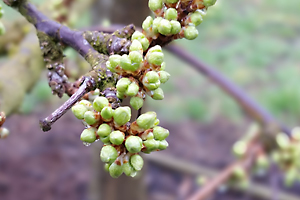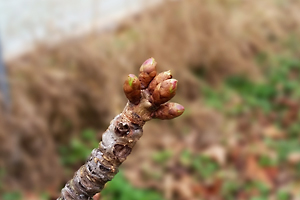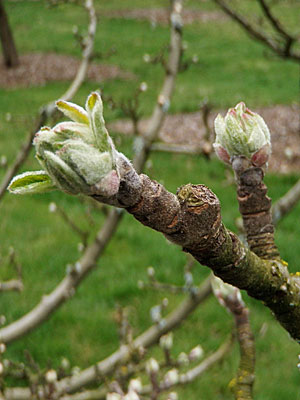Last month, we wrote about root stocks, and how they influence the way a fruit tree grows. Why don’t you graft several varieties onto the same root stock and save space? It sounds great, doesn’t it? 4 or 5 varieties of apple, all on one tree! Both pie and sweet cherries on one tree! How about plums and peaches together-an on-the-tree fruit cocktail! No worries about pollination, long fruiting season….why doesn’t Cloud Mountain carry trees like these?

Akane apples
It’s a question we get asked every year. But we like to carry plants that really work for people. Fruit trees are not that easy to start with, and learning to prune them correctly can be a life long effort. Each kind of fruit tree is pruned slightly differently, and even sometimes different varieties are pruned differently. When you start talking about multiple varieties grafted to one tree, you increase the challenge of keeping that tree fruiting.
Every variety of fruit has it’s own characteristics- vigor, disease resistance, bearing type. Each of those characteristics requires some knowledge in pruning and care to keep the tree balanced and fruitful. When each branch of a tree has different characteristics, it take a skilled pruner to keep them all balanced. Without that skill, over time, the most vigorous variety takes over the tree, and the weaker varieties decline and die out. You end up with a single variety tree.
A better solution to small spaces is to plant several trees on dwarf or mini-dwarf rootstocks. Each variety has its own roots, so won’t out-compete the other varieties planted. We’ve seen some sites that even recommend planting two trees in the same hole- this could work if you can keep them adequately watered and fed, and will present its own pruning challenges.
Is winter finally over? With this week’s warming temperatures, we’re starting to see our orchards wake up, the buds swelling. Using the swelling of buds to time preventative sprays is the most accurate way to control diseases on your fruit trees.

Japanese plum buds, at stage 3
By watching the buds on your fruit trees, you can time fungicide and bactericide sprays so they do the most good. And by using bud stages to time your sprays, you end up spraying less- always a good goal.

Cherry buds at stage 2, almost to stage 3
Recently, plum and cherry buds are starting to swell, so now’s the time to look at your trees for timing. Stage 3 flower buds is a perfect time to spray an oil plus copper for cherries and plums. What do these sprays do?
- Oil in delayed dormant sprays smothers overwintering aphid and mite eggs
- Copper helps prevent bacterial canker infections, blossom blight and brown rot in stone fruit trees.

Apple bud stage 4
How about your apples and pears? It’s early for these, but here are the signs you should be looking for: apples and pears should get a spray of oil plus sulfur between stages 4 and 6.
- Again, the oil in the delayed dormant spray will smother overwintering aphid, scale and mite eggs
- Sulfur helps prevent powdery mildew at this stage.
Once pears and apples hit stage 4, the flowers can open pretty fast. If you grow varieties that are susceptible to apple or pear scab, you will need to be ready to spray a sulfur spray (with no oil) once your blossoms swell just to the point of showing color (pre-pink, or stage 6). Add Bacillius thurengenisis (Bt) to this spray to get the first hatch of leaf rollers. A second sulfur spray at petal fall will keep your trees healthy and mostly scab free.

